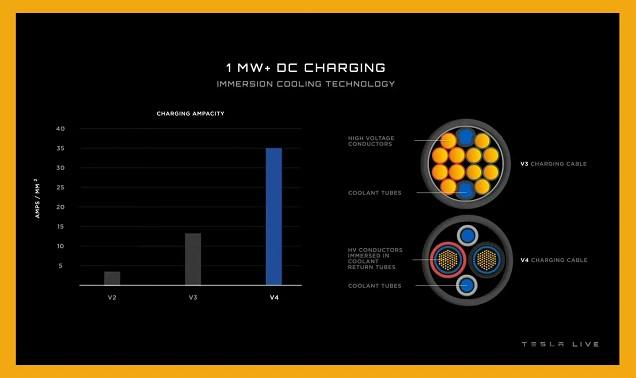Tesla Megacharger: 2.4 MW for the Semi, 1 MW for the Cybertruck?
According to an analysis, the two vehicles have to use different charging stations.
At the Semi Delivery Event on December 1, Tesla announced interesting things about the charging technology:
The Semi charged with over one megawatt, and the cable has a special liquid cooling system.

Elon Musk also revealed at the event
“It’s going to be used for Cybertruck, too.” It remained unclear whether the Cybertruck would charge at the same charging station as the Semi.
The video of an electrical expert now suggests that are two different chargers with different plugs.
Jordan Giesige from The Limiting Factor, a highly recommended battery channel, believes: The Cybertruck will be charged on a new Tesla Megacharger V4 in the future, while the Semi will need different Tesla Megacharger columns.
The cooling technology (with electrical conductors inserted directly into the water-based coolant) would be the same for both chargers.
The thicker cable of the Tesla Megacharger for the Semi would transmit about 2.3 MW, while the Supercharger V4 received a thinner cable and “only” manages about 1 MW.
Why does Jordan think they are two different types of pillars?
Well, firstly, the plugs are different. The image published by Teslarati of the connector for the Semi consists of two elongated elements and three connectors underneath.
The Tesla Megacharger V4 connector looks different as shown in ChunkAhoy’s 3D renderings based on 3D data released by Tesla.
2- Tesla writes on its Semi website
“Fast Charging – Up to 70% of range in 30 minutes.”
However, this would require more than 1 MW of peak power.
In the 500-mile version, the Semi should have a battery with a storage capacity of around 900 kWh, according to Jordan.
(We’d say at least because the thing is supposed to go 500 miles and use 2 kWh per mile, which works out to 1,000 kWh.)
Starting from 900 kWh, the Tesla Megacharger would have to squeeze 630 kWh into the battery in half an hour.
The average charging capacity would have to be 1,260 kW (1.26 MW), but the maximum charging capacity would be significantly higher, most likely beyond 2 MW.
Assuming a standard charging rate of 3C (i.e. the charging capacity is three times the number of kWh charged), then a 900 kWh battery would require a charging capacity of around 2.3 MW for a 70 percent charge.
How did Tesla manage to transfer such achievements?
The most important of this lies in the innovative cooling for the cable.
Even the latest version of the Tesla fast charger, the Supercharger V3 with a charging capacity of 250 kW, has a cooled cable.
A simple cooling circuit is used on the V3, with an inflow and an outflow. The electrical conductors are separated from this by cable sheaths for each core.

They are symbolized by the red and grey-green circles around the yellow wires in the upper right part of the following Tesla chart.
With the new cable cooling, on the other hand, the electrical wires lie directly in the coolant, as the chart explains: “HV conductors immersed in return tubes”.
If electrical wires are left in water without insulation, electrolysis usually occurs, and hydrogen and oxygen are produced. The cable would probably burst from the gases released.
But here there is only one electrode at a time – the positive one in the positively charged wire and the negative one in the negatively polarized conductor.
However, the cooling water around the positive and the negative conductor must not come together.
Tesla has therefore provided two cooling circuits in the new cable, one for the positively charged and one for the negatively charged water.
Jordan also believes that the Supercharger V4 isn’t hollow inside like Version 3 (see drawing below) because it contains a cooling system.
Jordan also understood in detail how the heat exchange works.
Jordan also believes that the first generation Cybertruck will not be able to use the full Supercharger V4 charging power of over 1MW.
He also suspects that the power of the Supercharger V3 will be increased from 250 to 300 kW. That would save Model 3/Y a time saving of two to three minutes when fast charging.
With the Model S and X, which Jordan says have better cooling and different battery chemistry, it would even be six to 10 minutes.
However, the Tesla Megacharger (Supercharger V4) would bring the greatest benefit to the Cybertruck with its larger battery – the car could have a 168 kWh battery, Jordan estimates.
Related Post
